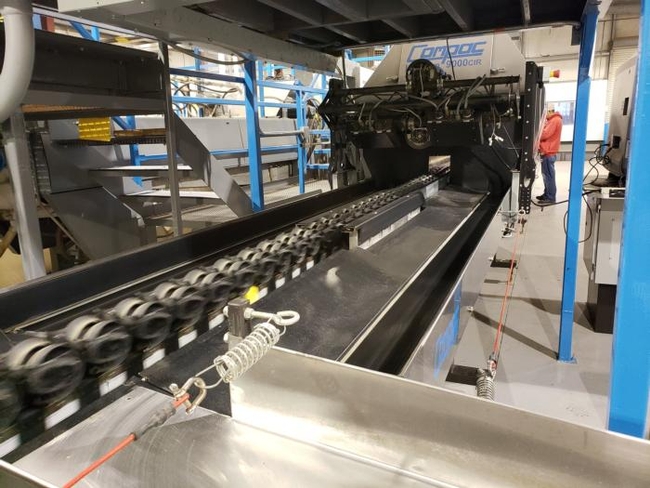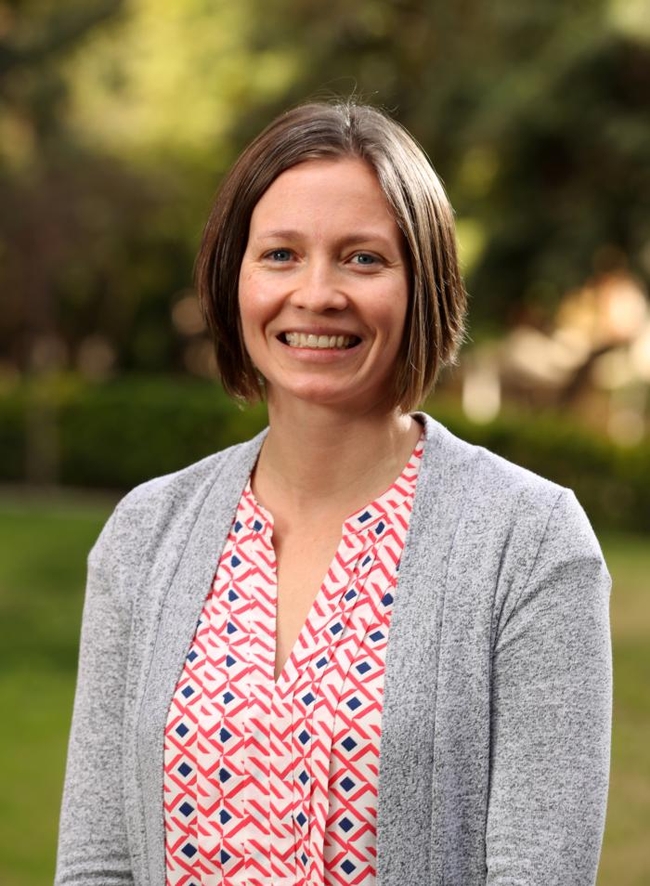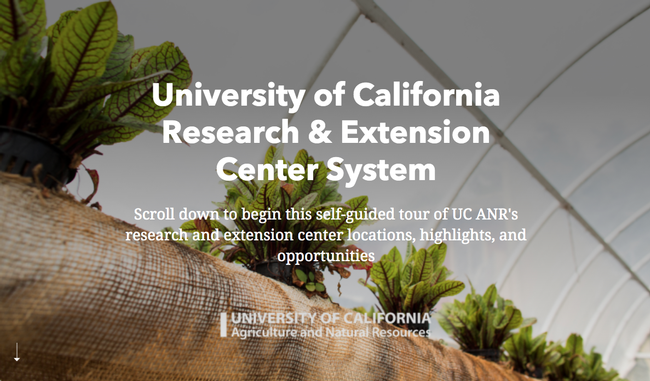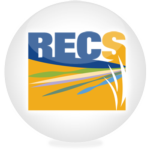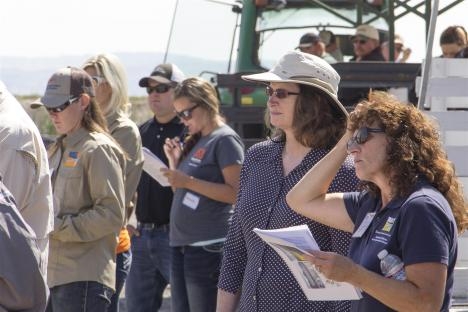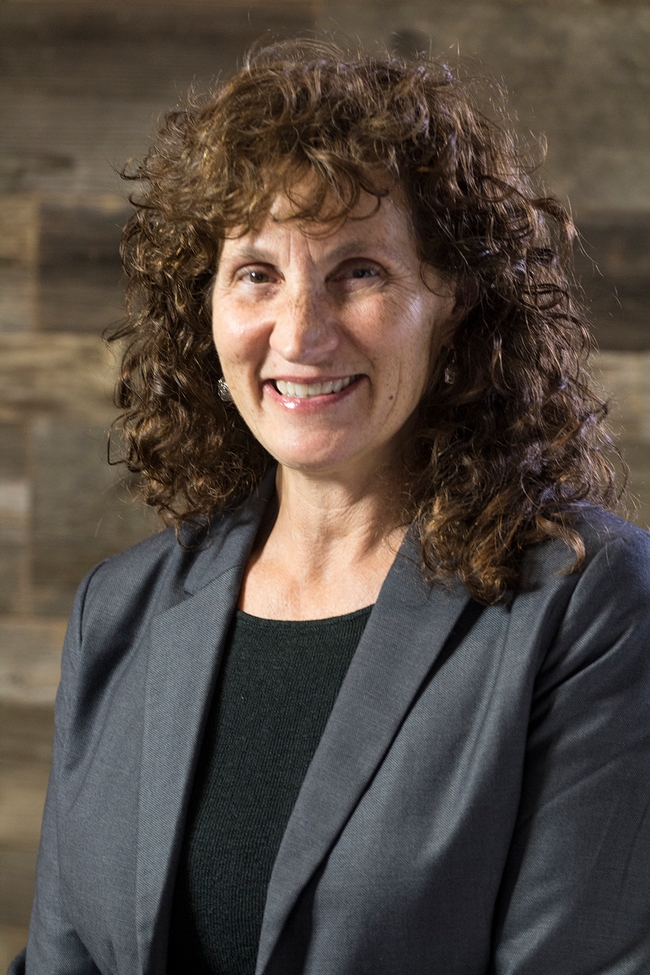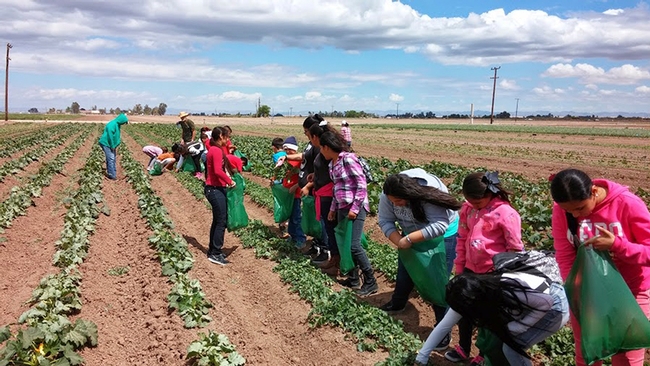Posts Tagged: Research and Extension Centers
Meet the people who do research at RECs
The University of California's nine Research and Extension Centers (RECs) are the only statewide program in the UC system that provides a premier research management environment including land, labor, facilities and equipment that delivers services to academics and the public.
But have you ever wondered what this kind of research looks like or who the researchers are? In a new spotlight series, we showcase REC researchers and their work.
Through these interviews, you will learn how these scientists became interested in their chosen field, what it is like to carry out research at the RECs, and what results may come from their work.
“The research staff are truly exceptional and have made it possible for us to successfully execute these large-scale projects,” saidDanelle Seymour, assistant professor of genetics at UC Riverside, reflecting on her experience conducting research at Lindcove REC. “There is something very special about the site. Coming from the crowded Inland Empire, it is refreshing to spend a week surrounded by swaths of commercial citrus groves with the Sierra Nevada in the background. I continue to look forward to each visit.”
Scientists across the state are hard at work to bring new research-backed information and solutions to make California agriculture and natural resources management more sustainable. Visit the Researcher Spotlights to learn more about this work, the benefits of conducting research at the RECs and how these talented researchers from a wide variety of backgrounds came to love their chosen fields.
Visit https://recs.ucanr.edu/researcherspotlights or click the linked names below to view their story:
Ali Montazar is studying irrigation and nutrient management at Desert REC.
Ben Faber is researching how plants grow at Hansen REC.
Brooke Latack is identifying techniques to improve cattle productivity at Desert REC.
Dan Preston is working on amphibian disease ecology at Hopland REC.
Danelle Seymour is measuring traits related to fruit size, shape and quality at Lindcove REC.
Daniel Putnam is testing alfalfa varieties at Intermountain REC.
Eric Seabloom is testing how global changes are altering ecosystems at Hopland REC.
Gaby Maier is working on research projects involving grazing cattle at Sierra Foothill REC.
Gail Taylor is working on lettuce at Desert REC.
Ian Grettenberger is working on the management of alfalfa pests at Intermountain REC.
John Angelos is researching pinkeye in cattle at Sierra Foothill REC.
Laura Snell is studying livestock mortality at Intermountain REC.
Nestor Kippes is studying the performance of northern California crops at Intermountain REC.
Oleg Daugovish is studying how strawberries respond to soil-borne pathogens at Hansen REC.
Oli Bachie is looking at new and alternative crops at Desert REC.
Pedro Carvalho is researching feed additives to enhance cattle growth at Desert REC.
Philippe Rolshausen is researching the citrus disease huanglongbing at Lindcove REC.
Scott Lewis Stephens is studying fire and chaparral at Hopland REC.
Sonia Rios is testing herbicide efficacy on avocado trees at South Coast REC.
Themis Michailides is a plant pathologist and researcher at Kearney REC.
Tom Dudley is conducting invasive species projects at Hansen REC.
Valerie Eviner is investigating how plants provide key ecosystem functions at Hopland REC.
Take a virtual tour of the 9 RECs
UC ANR operates nine Research and Extension Centers (RECs), each location representing a unique climatic zone of the state. Extending from the Oregon border in the north, through the Sierra Foothills and Central Valley, along the Pacific Coast and south to the Mexico border, the REC System covers rich and unique resources connecting research and extension activities to regional challenges and issues. Now you can tour all of them without leaving your desk.
A virtual tour of UC ANR's nine research and extension centers is posted online at https://storymaps.arcgis.com/stories/3eac885337854895bd7039d7d4a131f1.
“The new REC tour was made to showcase a taste of the research and extension that goes on within the UC ANR REC System,” said Kathy Eftekhari, chief of staff to the vice president. “It was developed for general distribution to possible new partners across UC, CSUs, other research and Extension institutions across the country, private industry, state and local agencies, etc.
Employees are encouraged to view the tour and share it with interested stakeholders.
“Many people even within ANR are not fully aware of what goes on at each REC,” Eftekhari said.
Research costs for RECs established
Following up on previous messages, the Rate and Recharge Committee and Associate Vice President Tu Tran have approved the full-costed rates for each of the nine Research and Extension Centers (RECs). This represents a major accomplishment given the change this year to a ‘line of service' approach to establishing research costs at each REC. The staff and director at each REC are to be commended for their effort, along with Deb Driskill, Han Pham and Jennifer Bungee.
Each REC director now has information regarding the amount of funds they have available for FY18-19 to fund down projects. The REC directors are working with Deb Driskill and the appropriate REC business officer to determine the researcher cost for each line of service. Full cost rates will be posted for each REC. Project investigators who have requested to conduct projects at a REC will be notified of the researcher cost for their project. It is intended that this information is available and shared by each REC director in the next couple of weeks.
We appreciate your patience while each REC works through this process. The overarching goal is to support research to the greatest extent possible with funds available. Furthermore, it remains the goal to be able to provide researchers who are applying for multi-year grants, the cost for the duration of the grant submission. This represents a change from past practice and one of the primary goals of the transition to a new way of costing research.
Sincerely,
Glenda Humiston, vice president
Wendy Powers, associate vice president
Tu Tran, associate vice president, Business Operations
Jeff Dahlberg, director, Kearney Agricultural Research and Extension Center
Jairo Diaz, director, Desert Research and Extension Center
Jose Fernandez De Soto, director, Hansen Agricultural Research and Extension Center
Beth Grafton-Cardwell, director, Lindcove Research and Extension Center
Darren Haver, director, South Coast Research and Extension Center
Bob Hutmacher, director, West Side Research and Extension Center
Jeremy James, director, Sierra Foothill Research and Extension Center
Kim Rodrigues, director, Hopland Research and Extension Center
Rob Wilson, director, Intermountain Research and Extension Center
RECs develop new funding model
The Research and Extension Center (REC) System is a key component of UC ANR (Cooperative Extension + Agricultural Experiment Station + Research and Extension Centers + Statewide Programs). Each of the nine RECs is unique and offers a wide array of opportunities to research and extension personnel within the University of California, and to our external partners. UC ANR will continue to deploy funds to support research projects. However, these funds do not go as far because salaries, benefits, and infrastructure expenditures continue to rise, while state and federal support for the Land Grant systems declines or remains flat.
To address these budgetary issues, cost increases must be offset by increasing the proportion of research costs covered by research projects. We project that approximately 25 percent of today's central funding will need to be redirected to cover increases in personnel salaries and benefits, deferred maintenance, strategic investments to ensure long-term operation of the REC system for generations to come, and increases in operating expenditures that are not included in research expenses. Increased expenses will be covered over time through a combination of fund development, increased revenue generated through increased programming and services, increased efficiency of business operations, and a reduction in the current level of research funding by UC ANR which, at present, averages approximately 80 percent across all REC supported projects.
For over a year now, we have been working to secure a bright future for the REC system by looking at the research that is conducted at each REC and considering how we do business now and in the future. In addition to the current work and programming that occurs at each REC every day, there is incredible untapped potential for new research and programs. Improved understanding of the cost to conduct research has been a key part of the review process undertaken at each of the centers over the past year. A deep dive into the accounting and cost structure has occurred at each facility; identifying the lines of service at the facility and the costs to provide those services. The FY 2018-19 cost structures for each center have been submitted to the UC ANR Rate and Recharge Committee for review this past week. Following review, the REC system will receive feedback and recommendations for changes to be made prior to rate approval.
We aim to have the full cost structures approved by late April 2018. Concurrent with the effort to identify costs for each line of service is work by each REC director to identify the level of funding that will be available in their individual budgets to reduce those costs to support research projects at each facility. We anticipate these rates will be available in late April for projects conducted in FY 2018-19 and with estimates for FY 2019-20 available at the same time.
Continuing a long tradition of supporting impactful research at each REC to solve agricultural and natural resource issues remains our highest priority. Ramp up of fund development efforts and identification of new or additional income opportunities at each REC will take time as will the ability for these strategies to offset research costs. In the meantime, the REC directors have identified that providing extra financial support to UC academics who have been in their jobs six years or less is critical to the success of new and early-career UC academics. To the extent that UC ANR funding permits, extra financial support may also be provided to support exploratory or high risk/high reward projects, projects that extend critical, under-funded, long-term research, and projects conducted by PIs who are first time users of the REC.
While the current budgeting efforts come with uncertainty and discomfort in the short-term, change is needed to secure long-term success. The leaders of each REC and UC ANR senior leaders are committed to transparency of research costs, exemplary customer service and investment into facilities and infrastructure that further our ability for sustained growth of the REC System.
Sincerely,
Glenda Humiston, vice president
Wendy Powers, associate vice president
Tu Tran, associate vice president, Business Operations
Jeff Dahlberg, director, Kearney Agricultural Research and Extension Center
Jairo Diaz, director, Desert Research and Extension Center
Jose Fernandez De Soto, director, Hansen Agricultural Research and Extension Center
Beth Grafton-Cardwell, director, Lindcove Research and Extension Center
Darren Haver, director, South Coast Research and Extension Center
Bob Hutmacher, director, West Side Research and Extension Center
Jeremy James, director, Sierra Foothill Research and Extension Center
Kim Rodrigues, director, Hopland Research and Extension Center
Rob Wilson, director, Intermountain Research and Extension Center
View or leave comments for ANR Leadership at http://ucanr.edu/sites/ANRUpdate/Comments.
This announcement is also posted and archived on the ANR Update pages.
REC System director Lisa Fischer reflects on strengths and potential of the research and extension centers as she retires
After a nearly 30-year career that took her from the U.S. Forest Service to director of UC ANR's Research and Extension Center system, Lisa Fischer is retiring. Her last day is Sept. 30. Darren Haver will serve as interim associate director through the end of the fiscal year.
Fischer joined ANR five years ago as the associate director of the Research and Extension Center system, after more than two decades with the U.S. Forest Service. She was later promoted to director of the RECs.
UC's ANR's nine Research and Extension Centers (RECs) connect UC research and education activities to regional challenges and issues. The nine centers extend from the Oregon border south to Imperial County. Each center has a unique focus. They provide land, labor, facilities and equipment that serve as an outdoor laboratory for researchers focusing on agriculture and natural resources. The RECs also serve as focal points for community participation and education, serving as hubs for UC ANR programs such as Master Gardeners, Master Food Preservers and 4-H. UC ANR RECs also partner with non-UC researchers, including scientists from U.S. Department of Agriculture and California State University. This is publicly funded research at its best.
We recently sat down to talk about her career.
What did you do prior to joining UC ANR? How did that work equip you for your career here?
Prior to joining ANR, I spent 21 years with the U.S. Forest Service. I managed and oversaw statewide and regional programs focusing primarily on forest health for California, Hawai'i and the Pacific Islands. Other statewide programs I was responsible for included conservation, education and forest stewardship. In many ways, the work was similar to the kind of work we do at ANR: working with state and private interests and other cooperators to deliver a full suite of programs to clientele.
I had a very long relationship with UCCE before joining the organization. My relationship with ANR dates back to the mid-1990s, when I was involved in a collaborative project with the Integrated Hardwood Range Management Program.
You received your degrees in Geography from UC Santa Barbara. How has that discipline helped you in your ANR career?
Fischer: Geography is about observing patterns in nature. When I think about that and my journey for the last five years, that disciplinary training seems incredibly applicable. Literally my first goal as Associate Director was to observe: to visit each REC, see what was happening, what each did and what each had to offer. It related not only in terms of learning the unique aspects of each REC, but how each fit into what I can only term a massive, grand and complex system.
For the first nine months, I was simply taking in a great deal of information. The time observing the RECs and speaking with a wide range of people (both within and outside of ANR) enabled me to identify some areas that we really wanted to try expand upon.
A key goal coming in was to increase the visibility of the REC system…to create more of a REC brand. There was another piece to that, which was considering how we might begin to engage in different activities, and considering what that would require.
The process of getting out and exploring possibilities with the REC directors was immensely fun, engaging and productive. We visited campus departments and spoke with graduate students, including those enrolled in geography, ecology and plant sciences.
UC ANR has done a wonderful job of providing hands-on experiences for K-12 and for UC and CSU students. It was also important for me to provide experiences for community college students. One of things I did early on with Bill Frost's blessing was to create an intern program. Initially, we were looking at how students might help us help to gain visibility, but we realized that these experiences might lead to future employment opportunities for these young people. So, I wove that into the pattern I saw.
I have always tried to be creative and consider how we can grow our REC system both internally as well as externally.
The RECs are being used in some new and exciting ways. Could you elaborate on that?
I'm very passionate about the Extension part of our work. Internally, I began having conversations in hallways about bringing groups together that could actually be present at the RECs. A central question was “How can we use these inter-connected physical places and locations across the state to benefit and host the full suite of ANR programs?”
One of the first centers to do this was South Coast REC in Irvine, where Director Darren Haver brought Cooperative Extension county programs and REC programs under one umbrella. Slowly, we also did that this at Hansen Agricultural Research and Extension ECenter (HAREC) in Ventura County. And for the first time ever, every acre at HAREC is being used for research and educational activities. More academics are engaging with RECs. We've improved.
Another creative and interesting opportunity has arisen from taking amazing research and programmatic work, and packaging it and delivering it in various ways to different audiences, from K-12 to the general public to international groups. Having RECs focusing on outreach, integrating programs and bringing different ideas for new outreach efforts has been very successful on a number of fronts. For example, Project Learning Tree uses RECs as places to convene different clientele and stakeholders. They conduct not only forestry-related teacher training, but also training to equip those educating others about natural resources, agriculture, wastewater and more.
We've really expanded the community educator capacity in the REC system. A model for the great potential of this work has been the Farm Smart program at Desert REC (DREC) in Imperial County. Farm Smart provides an on-site educational program serving grades K-12 and winter visitors (“snowbirds”). To date, it's served over 120,000 people. It's a very successful outreach and extension program that integrates a REC-based program with a county-based program. We've used Farm Smart as a model to launch other programs and educator positions across the system, including Sustainable You, a youth-development program that's involved 4-H, Master Gardener volunteers, the California Naturalist Program, Project Learning Tree and other county-based community educators. Sustainable You – a program developed by Utah State University – has launched at several RECs.
Which accomplishments are you most proud of?
I think that the strategic planning effort we undertook was absolutely amazing. When I came to ANR five years ago, one of the tasks given to me was to lead the creation of fully stakeholder-driven strategic plans. The process we developed to create these plans was amazing. Each of the nine centers convened committees consisting of stakeholders, specialists and advisors within thematic areas that were unique and critical to each REC.
It was a creative and open process that allowed for a continual flow of information from many and diverse parties.
It has been inspiring to develop and look out at a long-term plan (each plan projects out 20 years). What will the center look like? What will the work look like? What will the research facilities look like? How will we get there? The unique part of these plans is that they key in on a broad, strategic lens that reflects public values, such as enhanced science literacy. Goals are considered through these lenses, which has resulted in very strategic and creative action plans. These plans include anticipated outcomes and expected deliverables, but provide flexibility to adapt as the need arises. These are living plans that REC directors and their successors can reference, utilize, refine and use to guide annual work.
The strategic planning process also broadened our thinking and created an entire new set of questions about who we might work with at each REC, and the diversity of research efforts that might be undertaken in the future. Could we work with engineers? Artists? Writers? How do we expand partnerships in ways that not only help us maintain fiscal health and stability, but in ways which will enhance the diversity of research and education activities? Because of the sprawling nature of the REC system and the physical space that divides us, we've even discussed distance learning.
After five years, what's your takeaway about the REC system you've managed?
My perspective on the REC system is that it represents a simply amazing breadth of ecosystems and much of the amazing geographic and physical diversity that characterizes California. It's a unique place-based system that incorporates research, education, outreach and extension.
I feel as if I've just touched on the surface of what's possible here.
What would you want to tell advisors and others beginning their career with UC ANR?
Until I got involved in this position, I had no true understanding of how extraordinarily valuable a resource the RECs are for researchers and California taxpayers. These diverse physical locations exist as creative spaces for research and programmatic development and delivery. Opportunities abound. The potential is unlimited.
I'd also tell people to keep their eyes open and to consider the other kinds of research and programmatic opportunities that might arise. Step outside of the box a bit. It's essential to keep the research and extension mission in focus. But knowing that is our focus, it's important to note that research is very expansive: there are social, physical, biological, chemical, mechanical, and cultural aspects of critical issues that can be explored. Research can be conducted in any number of disciplines at the RECs. So, continue to seek out those different opportunities…that will assure that ANR remains in the forefront of creative research and Extension work.
I feel very strongly about that.

